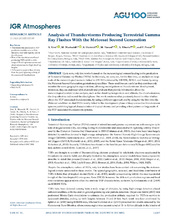Analysis of Thunderstorms Producing Terrestrial Gamma Ray Flashes With the Meteosat Second Generation
Peer reviewed, Journal article
Published version

Åpne
Permanent lenke
https://hdl.handle.net/1956/22514Utgivelsesdato
2019Metadata
Vis full innførselSamlinger
Originalversjon
https://doi.org/10.1029/2018jd030149Sammendrag
Up to now, only few works focused on the meteorological context leading to the production of Terrestrial Gamma ray Flashes (TGFs). In this study, we carry out, for the first time, an analysis on large scale of the meteorological scenario linked to 278 TGFs detected by RHESSI, AGILE, and Fermi, by using the Meteosat Second Generation geostationary satellites. These satellites are useful as they continuously monitor the same geographic region in time, allowing investigations on thunderstorms' development; moreover, they are endowed with channels and products that provide information about the meteorological context under analysis, such as the cloud top temperature and altitude, the cloud extension, the drop effective radius and the cloud phase. Our work confirms what previously found in other studies about the TGF‐associated thunderstorms, by using a different approach and by using for the first time the Meteosat satellites: we find TGFs mostly linked to the development phase of deep convective thunderstorm systems, exhibiting typical characteristics of tropical storms, and providing a first picture on large scale of the TGF‐associated thunderstorm systems.